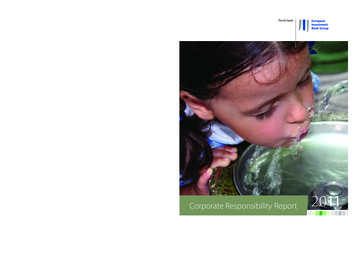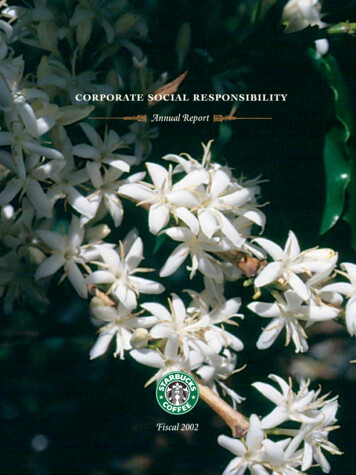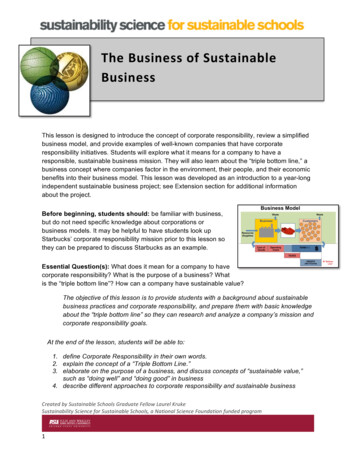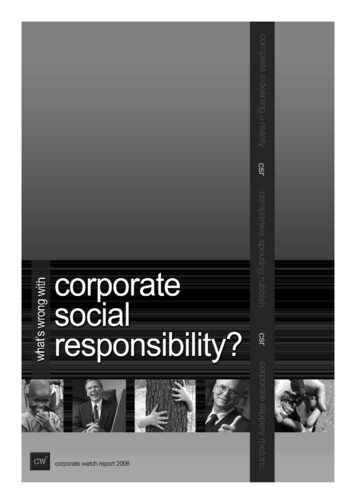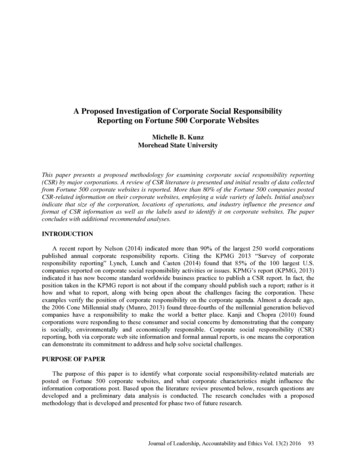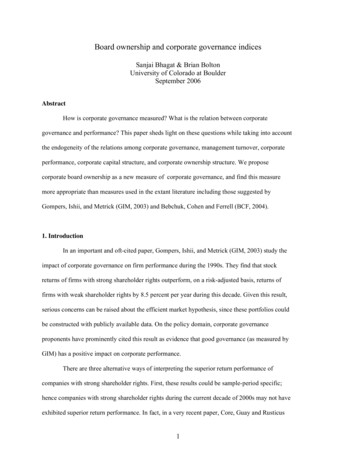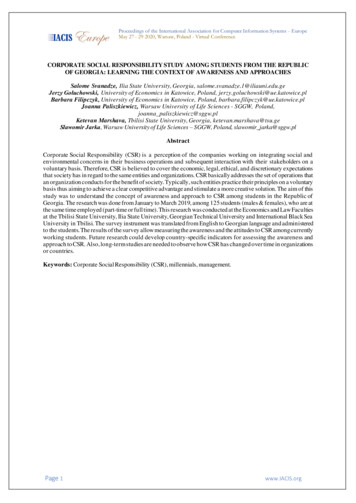
Transcription
Proceedings of the International Association for Computer Information Systems - EuropeMay 27 - 29 2020, Warsaw, Poland - Virtual ConferenceCORPORATE SOCIAL RESPONSIBILITY STUDY AMONG STUDENTS FROM THE REPUBLICOF GEORGIA: LEARNING THE CONTEXT OF AWARENESS AND APPROACHESSalome Svanadze, Ilia State University, Georgia, salome.svanadze.1@iliauni.edu.geJerzy Gołuchowski, University of Economics in Katowice, Poland, jerzy.goluchowski@ue.katowice.plBarbara Filipczyk, University of Economics in Katowice, Poland, barbara.filipczyk@ue.katowice.plJoanna Paliszkiewicz, Warsaw University of Life Sciences - SGGW, Poland,joanna paliszkiewicz@sggw.plKetevan Marshava, Tbilisi State University, Georgia, ketevan.marshava@tsu.geSławomir Jarka, Warsaw University of Life Sciences – SGGW, Poland, slawomir jarka@sggw.plAbstractCorporate Social Responsibility (CSR) is a perception of the companies working on integrating social andenvironmental concerns in their business operations and subsequent interaction with their stakeholders on avoluntary basis. Therefore, CSR is believed to cover the economic, legal, ethical, and discretionary expectationsthat society has in regard to the same entities and organizations. CSR basically addresses the set of operations thatan organization conducts for the benefit of society. Typically, such entities practice their principles on a voluntarybasis thus aiming to achieve a clear competitive advantage and stimulate a more creative solution. The aim of thisstudy was to understand the concept of awareness and approach to CSR among students in the Republic ofGeorgia. The research was done from January to March 2019, among 125 students (males & females), who are atthe same time employed (part-time or full time). This research was conducted at the Economics and Law Facultiesat the Tbilisi State University, Ilia State University, Georgian Technical University and International Black SeaUniversity in Tbilisi. The survey instrument was translated from English to Georgian language and administeredto the students. The results of the survey allow measuring the awareness and the attitudes to CSR among currentlyworking students. Future research could develop country-specific indicators for assessing the awareness andapproach to CSR. Also, long-term studies are needed to observe how CSR has changed over time in organizationsor countries.Keywords: Corporate Social Responsibility (CSR), millennials, management.Page 1www.IACIS.org
Proceedings of the International Association for Computer Information Systems - EuropeMay 27 - 29 2020, Warsaw, Poland - Virtual ConferenceCONSUMERS ENGAGEMENT IN BUSINESS PROCESS INNOVATION – CASES FROM POLANDAND UK*Monika Eisenbardt, University of Economics in Katowice, monika.eisenbardt@ue.katowice.plEwa Ziemba, University of Economics in Katowice, ewa.ziemba@ue.katowice.plRoisin Mullins, Faculty of Business and Management, University of Wales Trinity Saint David, UnitedKingdom, r.mullins@uwtsd.ac.ukSandra Dettmer, Faculty of Business and Society, University of South Wales, United Kingdom,sandra.dettmer@southwales.ac.ukAbstractThe main purpose of this paper is to identify how Poland and UK-based ICT companies engage consumers ininnovation in business processes. The methodology adopted for this research was a case study approach with twotarget research samples – Poland and UK-based companies that engage consumers in innovation in businessprocesses. Ultimately, 1053 case studies of consumers' engagement in business processes were evidenced as thebasis of our research. We used the UK Standard Industrial Classification of Economic Activities (SIC 2007) as ameans to classify and verify the assignment of an industry to the case studies gathered. We were focused on thecompanies applicable to the J category – Information and communication. Finally, we confirmed a sample of 48ICT companies – consisting of 24 from Poland and 24 UK-based ICT companies. We employed statistical teststo analyse differences and similarities between Poland and UK-based ICT companies in the innovations theyexpect consumers to engage in. Our results present a detailed insight into business processes in which consumers’innovation can be utilized. Particularly, they show that for three out of four business processes – BP 3.0; BP 4.0;and BP 5.0 (according to APQC Process Classification Framework) there were s ignificant differences betweenPoland and UK-based companies in the range of innovation in business processes that companies expectconsumers to engage in. Also, our results make more understandable the means of consumers’ engagement ininnovations. Particularly, they show that the significant differences between Poland and UK-based ICT companiesare concerned with only one mode of consumer innovations, i.e. creating and designing products or their parts.What is more, the results provide insight into incentives encouraging consumers to engage in innovation activities.More specifically they show that the differences between the two countries were related to tangible incentives,i.e. material reward, monetary compensation, and bonus points with financial values. As to the technologies, ourresults show that in four cases – e-mails; specialized organizations' websites; popular information websites; andmobile applications – there were significant differences between Poland and UK-based companies in ICTs offeredto consumers to facilitate their engagement in process innovations. Our results can be useful especially for Polandcompanies as they show that UK-based ICT companies offer more opportunities for engagement, more incentives,and more ICT solutions to their consumers than Poland ones. In turn, it may mean that UK-based ICT companieswill be more able to gather and implement consumers with innovative ideas to better improve their businessprocesses.Keywords: Consumers engagement, business process innovation, ICT companies*Selected to appear in JCISPage 2www.IACIS.org
Proceedings of the International Association for Computer Information Systems - EuropeMay 27 - 29 2020, Warsaw, Poland - Virtual ConferenceBUSINESS INTELLIGENCE BASED PRODUCTIVITY DEVELOPMENTKaisa Ylinen, University of Vaasa, kaisa.ylinen@uva.fiJosu Takala, University of Vaas, josu.takala@uwasa.fiTeppo Forss, TVT, teppo.forss@tvt.fiAbstractThe aim of the research was to evaluate the productivity of a service process in the context of housing services.The study was done as a case study and the case company was a housing company in Finland. The intention wasto provide an overview of the process over multiple internal departments and compare the changes over a periodof time. This case study viewed a service process with the Total Productivity Model by Dr David J. Sumanth(1998). The inputs and outputs of the process were identified via interviews and they formed the basis of theprocesses’ productivity model. The main output was the output of the service process, whereas the number ofinputs was higher since the process requires the participation of multiple internal departments. The case companyprovided data from its operational and financial systems from 2016 to 2019. The analysis utilised a BusinessIntelligence tool (PowerBI) in order to combine data from multiple sources. This case study was able to providean overview of the main aspects of the service process and enable comparison between each year. Discussion withthe case company confirmed that the results are aligned with their previous understanding of the business process.The study detected certain parts of the process could be the biggest potential for productivity growth. Additionally,the study provided insights into company data availability and quality. The case company has a lot of operationaldata, but since all parts of the process are not yet digitalised, the relevant data is not available and the modelneeded to be modified accordingly. This research provided multiple implications. Firstly, due to the nature ofservices, evaluation of service productivity is a challenging task. Sumanth’s Total Productivity Model requiredcertain customisation in order to fit the case. Nevertheless, this study was able to combine data in a way that isnovel for the case company, consequently providing practical suggestions for process improvement. Asimplications for digitalisation, this research shared light on available data and suggestions for processdigitalisation, so that management would get transparency on the process, and therefore be able to make betterbusiness decisions. Due to the nature of services, it is not straightforward to build a model for productivityevaluation. Nevertheless, Sumanth’s Total Productivity Management model provided a basis for evaluating thepartial productivity of this service process. Consequently, the model was able to show an overview of the processproductivity and its changes over the years. Additionally, the study detected productivity improvementsuggestions. Lastly, this research provided practical insights and proposals for the case company on theirproductivity assessment, process digitalisation and the potential of utilising data in their operational planning andimprovement.Keywords: Business intelligence, productivity development, housing servicesReferencesSumanth, D. J. (1998). Total productivity management (TPmgt): a systemic and quantitative approach tocompete in quality, price and time. CRC Press.Page 3www.IACIS.org
Proceedings of the International Association for Computer Information Systems - EuropeMay 27 - 29 2020, Warsaw, Poland - Virtual ConferenceBLOCKCHAIN TECHNOLOGY FOR RENEWABLE ENERGY: PRINCIPLES AND APPLICATIONSOskar Juszczyk, University of Vaasa, oskar.juszczyk@uwasa.fiJosu Takala, University of Vaasa, josu.takala@uwasa.fiAbstractBlockchains, or distributed and immutable ledgers, are an innovative technology that is emerging in the varioussectors and industries across the globe. It has attracted the attention of different interest groups such as e.g. energycompanies, SMEs and start-ups, information technology developers, financial institutions, national authorities orthe university community. This decentralized ledger is widespread mainly in the banking industry, often throughcorresponding banking, or syndicating and peer-to-peer (P2P) loans. Importantly, Blockchain technologyenhances transparency and authenticity of processes throughout the whole supply chain and thus, auditability ofall of the transactions recorded and updated every 10 minutes. Moreover, it assures the anonymity and privacy ofall of the actors involved. These factors are connected with an intangible, but a highly significant asset for themodern entrepreneurs, which is trust. Through the digitalization of the transactional mechanisms, Internet ofThings (IoT) implementation and smart contracting, the improvement of the business day -to-day operations isfirmly forecasted. However, this revolution in the Fintech sector is spreading across divergent industries. Anothersignificant benefit that Blockchain technology provides, mainly coming from its transparent nature, is thecapability to decrease the information asymmetries among the collaborating partners. In the energy sector, thedigitalization is already present in solutions such as smart grids, electric vehicles, vehicle-to-grid (V2G), etc.Moreover, a new concept of the Internet of Energy (IoE) has been introduced in the academic literature. In thisarticle, the level of trust and maturity of Blockchain technology implementation is investigated through theBlockchain maturity questionnaire, developed by the author. The database consists of upper managementprofessionals from the energy industry, including renewable energy companies. This methodology, as well asspecific target groups selected, makes this study an insightful and unparalleled information provider. The studyyields numerous applications not only for the renewable energy industry experts but also for the interest gro upscoming from different industries, as well as public authorities and researchers scrutinizing the fields taken into itsscope.Keywords: Blockchain; Internet of Things (IoT); Internet of Energy (IoE); Peer -to-Peer (P2P); RenewableEnergyPage 4www.IACIS.org
Proceedings of the International Association for Computer Information Systems - EuropeMay 27 - 29 2020, Warsaw, Poland - Virtual ConferenceCORE AGILE PRACTICE ACCOMPLISHMENT IN PROJECTSRosarito Sánchez-Morcilio, University of Puerto Rico, Río Piedras Campus, rosarito.sanchez@upr.eduFrancisco Quiles-Torres, University of Puerto Rico, Río Piedras Campus, francisco.quiles@upr.eduAbstractMany projects require the incorporation of technology as part of its scope. Agile project management is thedirection leaders follow today. The purpose of this study is twofold. First, we research and define core agilepractices. Second, we explain how projects accomplish core agile practice. Core agile practice is a set of practicalconcepts that, when applied, transform the project into a well-managed and successful endeavor. We usequalitative and quantitative methodologies to research both the core agile practice definition and the core agilepractice accomplishment in projects from organizations around the world. We find the core agile practicedefinition according to literature, as well as give examples of the core agile practice implementation on a projectfrom a wide variety of organizations. In conclusion, even though each project scope is unique, we present theapplication of core agile practice effectively to improve project management.Keywords: core agile, Agile Project Management, agile adoption, agile in organizationsPage 5www.IACIS.org
Proceedings of the International Association for Computer Information Systems - EuropeMay 27 - 29 2020, Warsaw, Poland - Virtual ConferenceSOCIAL NETWORKING SITES AND RESEARCHER’S SUCCESS*Anna Górska, Koźmiński University, amg@kozminski.edu.plGrzegorz Mazurek, Koźmiński University, gmazurek@kozminski.edu.plPaweł Korzyński, Koźmiński University, pkorzynski@kozminski.edu.plSusana Silva, Católica Porto Business School – Universidade Católica Portuguesa, ssilva@porto.ucp.ptAbstractThe purpose of this paper is twofold: to identify whether how the use of SNS may enhance the impact of theresearch and thus contribute to the academic success in terms of citations , and to gain a more comprehensiveunderstanding of which SNS may have a positive relation to the academic citations. This study drew from theresearch on social networks, SNS and higher education; and empirical study results. Researcher’s SNS use ispositively correlated with the academic citations rate – the higher the scholars’ presence in academic, professional,relationship, microblogging SNS, the higher scholarly success. This paper explores the association between aresearcher's social media presence on fathomable SNS (ResearchGate, LinkedIn, Facebook, Twitter) and the levelof citations – academic success.Keywords: Academic success; Scholarly success; Researcher’s success; Google citations rate; Academiccitations; Scholarly communication; Social networking sites; Social media*Selected to appear in JCISPage 6www.IACIS.org
Proceedings of the International Association for Computer Information Systems - EuropeMay 27 - 29 2020, Warsaw, Poland - Virtual ConferenceIOT-BASED KNOWLEDGE MANAGEMENT IN HEALTHCARE SYSTEMS IN POLANDEwa Stawicka, Warsaw University of Life Sciences, ewa stawicka@sggw.plAgnieszka Parlińska, Warsaw University of Life Sciences, agnieszka parlinska@sggw.pl,AbstractPoland has all the resources needed to develop telemedicine: technology, private capital ready for investment andpatients waiting for new solutions. Just the shift interest and the stream of money in this direction are needed. Thebenefits of using telemedicine solutions are obvious: savings resulting from the possibility of reducing investment:outlays on infrastructure; better use of working time of medical staff and increase of service quality through fasterdiagnosis and monitoring of treatment. In Poland, the growth rate of private spending on healthcare is 6 % peryear and is almost two times faster than public spending. Among the positives is the reduction of service costsresulting, among others, from reducing their number and shortening queues due to increased resource efficiency.In Poland over 80% of patients have Internet access, and 60% declare that they own a smartphone. Theteleconsultation services reach 110 percent growth per year, which means that the number of teleconsultationsdoubled during 12 months and amounted to over 110,000 in all of Central and Eastern Europe. The advancedtechnology used in healthcare can be a solution to the lack of budget money. The aim of the research is to assessthe use of IOT (Internet of Things) knowledge management in the healthcare system in Poland. Information anddata were taken from the literature and the reports of the Ministry of Digital Affair s, PWC Reports and NationalHealth Found Development Strategy for 2019-2023. The analysis was based on selected statistical measures andresults from the survey which help to answer the following research’s questions:1. How does knowledge management affect the development and use of IoT in healthcare systems?2. What trends can be observed in the demands and interests of patients in telemedicine?3. What are the main technologies supporting the development of telemedicine?In addition, selected results of the survey of the healthcare system and examples of IOT solutions in private andstate healthcare were presented.Keywords: knowledge management, IoT, telemedicine, healthcare systemsPage 7www.IACIS.org
Proceedings of the International Association for Computer Information Systems - EuropeMay 27 - 29 2020, Warsaw, Poland - Virtual ConferenceSHARING LOGISTICS - LITERATURE REVIEW AND FUTURE RESEARCH DIRECTIONSKonrad Michalski, Warsaw University of Life Sciences, Konrad michalski@sggw.plAbstractThe article is a review aimed at presenting the subject of and available knowledge on sharing logistics and atindicating further research objectives in this area. Research methods used in the study included an extendedliterature review, along with its critical analysis and logical deduction. The perspective of perception of sharinglogistics adopted by the author corresponds to organization management. The analysis shows that sharinglogistics – based on the sharing economy – could take full advantage of the opportunities created by the conditionsin the ubiquitous integration of systems and value creation processes. Logistics processes are activities of thiskind that play a significant role in creating a value of delivered products. But acting in the conditions of theopportunities created by sharing, not only material resources, requires logistics managers a changed approach tomany aspects of the current operation. However, the subject requires further empirical research. Limitations ofthe article apply to both the subject of sharing logistics itself and the literature review. There is a lack of complexreviews and scientific studies or in-depth empirical research on this topic. Certainly, however, the set of literatureused in the review does not exhaust the topic taken. The issues discussed in the article require further scientificresearches, first of all, empirical ones. The raised research should c over various aspects, such as a revision ofexisting paradigms, also in the area of management. To sum up, this is one of the first publications in this fieldthat falls within this research gap. This study constitutes a significant contribution to the development of researchon the subject of sharing logistics.Page 8www.IACIS.org
Proceedings of the International Association for Computer Information Systems - EuropeMay 27 - 29 2020, Warsaw, Poland - Virtual ConferenceSYSTEMIC APPROACH TO BIG DATA IN THE ORGANISATIONHubert Szczepaniuk, Warsaw University of Life Sciences, hubert szczepaniuk@sggw.plAbstractModern trends related to the development of IT systems supporting management imply the need for effectiveutilisation of information processed in conditions of heterogeneous and incoherent Big Data sets. Current researchwithin the aspect of Big Data indicates that for the purpose of their effective use in management, the classicanalytical tools are no longer sufficient. Most of the work from the field of the subject mainly focus on theoreticalconcepts from the fields of management or they consider detailed technical analyses within the aspect of IT.Modern management concepts often use IT technologies for the purpose of increasing the effectiveness of thefunctioning of an organisation and realisation of processes within them. Certain research gap is present within theaspect of lack of a systemic and synergistic research apparatus within the aspect of the potential which utilisationof Big Data in an organisation carries. Due to this fact, there is a need for research regarding a systemic approachto Big Data which would include achievements of management and quality sciences, IT and security sciences.The aim of this article is to develop a model of a systemic approach to Big Data which would include theorganisation perspective, covering elements of informational process and manage ment and the IT systemsperspective, and also the requirements within the aspect of information security. Realisation of the adoptedresearch goal will enable to detail the theory within the aspects of modelling Big Data processes and systems, alsoregarding theory and practice of organisation management and implementation of IT systems on the stage ofdesigning and selection of system architecture and data models. Research results show that it is possible toindicated and systemically approach the key fields determining the effectiveness of IT processes functioning inthe conditions of heterogenous Big Data sets. Research results have enabled to develop a model of a synergisticapproach to Big Data in an organisation and to identify challenges within the aspect of usage of Big Data and thefield of information security.Keywords: Big Data, systemic approach, data models, information securityPage 9www.IACIS.org
Proceedings of the International Association for Computer Information Systems - EuropeMay 27 - 29 2020, Warsaw, Poland - Virtual ConferenceA FLEXIBLE SYSTEM FOR INCREASING THE COMPETENCES OF TECHNICAL SERVICEEMPLOYEES USING VIRTUAL REALITY TECHNIQUESWojciech Drożdż – University of Szczecin, Wojciech.drozdz@wzieu.plMaciej Wachowiak – Enea Operator, wachowiakmaciej@gmail.comAbstractThis paper presents the possibilities of using virtual reality techniques in interactive training of technicalemployees of a Distribution System Operator (DSO). It also describes the concept, assumptions andimplementation method of the created Flexible Training System. Thanks to its capabilities, employees canparticipate in sophisticated training conducted in an innovative way eliminating the current disadvantages andlimitations of classic – “real” training approaches. The System enables practice in two main categories of trainingused in the DSO environment: commutating operations and live-line works. Benefits and risks associated withsystem implementation in DSO structures are presented.Keywords: virtual reality training system, virtual learning environment, training in the energy sector, trainingscenarios for transformer stationsPage 10www.IACIS.org
Proceedings of the International Association for Computer Information Systems - EuropeMay 27 - 29 2020, Warsaw, Poland - Virtual ConferenceEVALUATION OF THE PERCEPTION OF CRYPTOCURRENCIES AND THEIR ONLINEEXCHANGES IN POLAND IN 2019Marek Zborowski, University of Warsaw, mzborowski@wz.uw.edu.plOskar Szumski, University of Warsaw, szumski@wz.uw.edu.plAbstractThe main objective of this article is to identify the opinions of Internet users concerning cryptocurrencies as wellas to evaluate online exchange websites dedicated to this solution. The research was carried out with theapplication of the CAWI (Computer Associated Web Interview) method and examined a group of active Internetusers. The selection method was the case of a random-purposeful sampling of 239 participants. The survey wasconducted on the perception of the issue of cryptocurrencies and their online exchange websites in Poland in 2019.The study allowed for assessing the issue of cryptocurrencies considering the following criteria: familiarity withthe concept, sources of information about the phenomenon, investment preferences, awareness regarding securityas well as the knowledge concerning the advantages and disadvantages of the solution. The study into selectedcryptocurrency online exchanges has pointed to significant factors that determine the respondents’ choice of aparticular website to invest in. The conclusions and recommendations indicated in this article can contribute toimproving the design of cryptocurrency online exchange websites as well as the development of awareness of theexamined issue.Keywords: cryptocurrencies, alternative currency exchanges, website quality assessmentPage 11www.IACIS.org
Proceedings of the International Association for Computer Information Systems - EuropeMay 27 - 29 2020, Warsaw, Poland - Virtual ConferenceROLE AND MEANING OF EQUILIBRIUM AND LIMIT STATES IN RISK ANALYSIS, SECURITYAND FORENSIC SCIENCEDagmar Kopencova, University of Finance and Administration, dagmar.kopencova@seznam.czMiroslav Felcan, Academy of Police Forces at Bratislava, miroslav.felcan@minv.skRoman Rak, University of Finance and Administration, roman.rak@irisident.czAbstractBasic terms such as ‘phenomenon’, ‘event’, ‘state’, and ‘situation’ are defined for risk analysis and security needs.Other important terms include ‘equilibrium’ and ‘stability’ (as well as related terms ‘instability’ and ‘lability’).These terms can be found in both security and technical sciences as well as economics and social sciences. Thispaper generally defines and explains these key concepts across different disciplines and fields of human activity.Equilibrium states are known mainly from the field of physics - mechanics of solids. However, equilibrium states,stability and their changes are of great importance in the analysis of risks and safety, of various processes andobjects in engineering practice, but also in other areas of human activity. Steady state analyzes help to understand,define threats and risks and manage them effectively; improve the reliability, safety of technological and othercomponents or units. The paper is mainly of a theoretical nature and originated in research within the securitysciences.Keywords: Equilibrium, equilibrium position, balance of forces, stabilityPage 12www.IACIS.org
Proceedings of the International Association for Computer Information Systems - EuropeMay 27 - 29 2020, Warsaw, Poland - Virtual ConferenceTHE USAGE OF SMARTPHONE AND MOBILE APPLICATIONS FROM THE POINT OF VIEW OFCUSTOMERS IN POLANDWitold Chmielarz, University of Warsaw, witek@wz.uw.edu.plAbstractThe main objective of this article is to identify the conditions for the use of smartphones and mobile applicationsin Poland in the second half of 2018. The scope of the present analysis was limited to a selected sample of morethan 470 respondents and examined the group of the most active users of smartphones and mobile applications.The author adopted the CAWI - Computer Associated Web Interview method in his study, which was previouslyverified by a randomly selected pilot sample. The obtained results were compared with the findings of otherstudies. They indicated that users of smartphones and mobile applications in Poland do not differ in theirassessments from users in Europe and around the world. In this context, the key implication for researchers i s theidentified level of development of the use of smartphones and mobile applications in Poland at the end of 2018.The main limitation of the research was the selection of the research sample which consisted only of members ofthe academic community. The scope of this article aims to fill a gap in terms of the quantitative and qualitativemethods which are applied to examine the use of mobile devices and mobile software. At the same time, this studycreates the foundations for further research on intercultural differences. It is important to note that the presentresearch sample needs to be extended beyond the academic community for the research results to be fullygeneralised.Keywords: smartphones, mobile applications, evaluation of mobile applicationsPage 13www.IACIS.org
Proceedings of the International Association for Computer Information Systems - EuropeMay 27 - 29 2020, Warsaw, Poland - Virtual ConferencePURCHASE OF FOOD IN LARGE PACKAGES IN THE ASPECT OF FOOD WASTE IN POLANDMagdalena Ankiel, Poznań University of Economics and Business, magdalena.ankiel@ue.poznan.plUrszula Samotyja, Poznań University of Economics and Business, urszula.samotyja@ue.poznan.plAbstractFood waste has become one of the top issues for individuals and organizations involved in food marketing andfood policy. The presence of food waste and ways to reduce food waste has generated debate among industrystakeholders, policymakers, and consumer groups. According to FAO data, one-third of world food production iswasted, equivalent to 1.3 billion tonnes. Every year, almost 90 million tonnes of food are wasted in the EuropeanUnion, i.e. around 173 kg per person, which represents around 20% of EU food production. It is forecast that by2020 the total amount of food wasted in Europe will increase by 40%. In Poland, around 9 million tons of food iswasted, of which over 6.5 million tons are in the manufacturing sector, and over 2 million are in households.According to the European Commission, the share of food wasted at the consumption stage increases as the wealthof the population increases. In Poland, bread, fruit, vegetables, milk and its pr
provided data from its operational and financial systems from 2016 to 2019. The analysis utilised a Business Intelligence tool (PowerBI) in order to combine data from multiple sources. This case study was able to provide an overview of the main aspects of the service process and enable comparison between each year. Discussion with
